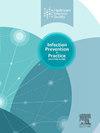3%过氧化氢用于消毒被尿液污染的表面
IF 1.9
Q3 INFECTIOUS DISEASES
引用次数: 0
摘要
对被尿液污染的地板、表面和物体进行消毒是医疗保健领域的一个长期挑战。虽然漂白剂等氯基化合物通常用于表面消毒,但众所周知,它们会降解塑料,可能留下有害残留物,并释放出潜在的刺激性蒸汽,因此不适合用于与人类直接接触的材料的消毒剂。本研究的目的是评估一种替代的尿液消毒程序。假设用3%过氧化氢(H2O2)处理尿液污染的表面可以去除细菌。此外,在适用的情况下,评估了同一种H2O2原液在一段时间内重复使用的效果,进一步提高了简便性和可及性。材料和方法对两种材料(平面塑料表面和较难清洁的长管腔)的消毒效果进行了评估,使用的是常用的水和肥皂方法,而不是使用3% H2O2溶液。结果当用肥皂和水清洗时,污染仍然存在,但对于平坦的塑料表面,H2O2储存1小时后有效去除,对于管腔表面,H2O2储存3小时后有效去除。相同的H2O2溶液可以重复使用长达三周,没有菌落形成。结论尿液污染表面,根据表面类型不同,在3% H2O2中浸泡1 ~ 3小时即可去除细菌,无需擦洗或冲洗。相同的原液可用于重复洗涤长达三周,以扩大其可持续性和可及性。本文章由计算机程序翻译,如有差异,请以英文原文为准。
3% hydrogen peroxide to disinfect urine-contaminated surfaces
Purpose
Disinfecting urine-contaminated floors, surfaces and objects is a persistent challenge in healthcare. While chlorine-based compounds such as bleach are often used to decontaminate surfaces, they are known to degrade plastics and may leave harmful residues and release potentially irritant vapors making them unsuitable disinfectants for materials that come in direct contact with humans. The objective of this study was to evaluate an alternative urine disinfection procedure. Treating urine-contaminated surfaces with 3% hydrogen peroxide (H2O2) was hypothesized to remove bacteria. Furthermore, when applicable, the efficacy of the same H2O2 stock solution for its repeated use over time was assessed further increasing simplicity and accessibility.
Materials and methods
The effectiveness of disinfecting two materials, a flat plastic surface and a long lumen representing a more challenging surface to clean, was evaluated with a commonly used method of water and soap versus using a 3% H2O2 solution.
Results
Contamination persisted when washing with soap and water but was effectively removed after one hour of H2O2 storage for flat plastic surfaces and after 3 hours for lumen surfaces. The same stock of H2O2 solution could be reused for up to three weeks with no colony formation.
Conclusions
The results show that bacteria can be removed from a urine-contaminated surface by being soaked in 3% H2O2 for one to three hours based on the surface type without the need for scrubbing or rinsing. The same stock solution can be used for repeated washes for up to three weeks to expand its sustainability and accessibility.
求助全文
通过发布文献求助,成功后即可免费获取论文全文。
去求助
来源期刊

Infection Prevention in Practice
Medicine-Public Health, Environmental and Occupational Health
CiteScore
4.80
自引率
0.00%
发文量
58
审稿时长
61 days
 求助内容:
求助内容: 应助结果提醒方式:
应助结果提醒方式:


